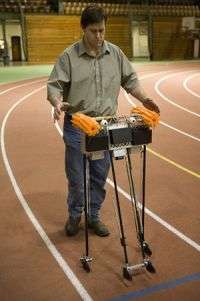Cornell robot fails to break a record, but students learn

Engineering education needs to include a few rough spots to be worthwhile. An attempt to set an unofficial world record for how far a robot could walk failed the night of March 30, but the team will keep trying.
The Cornell Ranger, a robot developed by a team of students working with Andy Ruina, professor of theoretical and applied mechanics, fell down after about 4.75 laps -- about .95 kilometers ( .59 miles) -- around the running track in Barton Hall. An earlier version of the same robot had already set a record by free-walking a bit over 1 kilometer, about .62 miles. (Another robot has walked 2.5 kilometers (1.55 miles) on a treadmill, Ruina noted.)
Ruina was hoping for 10 or more kilometers, more than 6 miles, depending on how long the robot's battery charge would last. The Ranger, like other robots developed in Ruina's lab, is designed for maximum energy-efficiency. Although its four-legged design makes it look a bit like a walking sawhorse, it mimics human walking technique, using energy only to push off with its pivoting toes, but depending on gravity and forward motion to swing its legs forward.
The goal of the research, Ruina said, is not only to advance robotics but also to learn more about the mechanics of walking so the information can be applied to rehabilitation and prosthetics for humans.
After a promising start, the robot literally stubbed its toe after failing to tilt one of its feet upward as the leg came forward. With that, the team of students went into an intense diagnostic session, reviewing telemetry that showed the signals sent by the robot's computer controller to its motors and switches, watching video of the fall and taking new video as the robot was repeatedly tested. The problem was eventually diagnosed as a loose connection in the wires leading to a sensor that measures the angle of the legs relative to the ground.
"I'm actually sort of glad this happened," Ruina said as he watched the students cluster around a laptop to review the robot's programming. "They need to learn that failures are a part of engineering in the real world."
Source: Cornell University





















